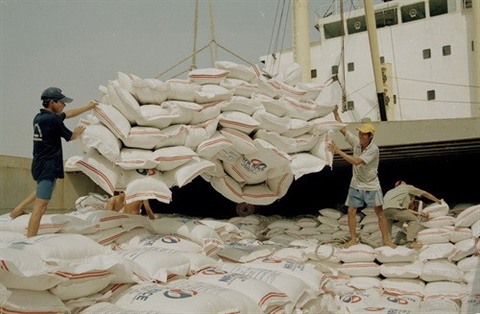
Workers load rice packages for export at Sai Gon Port. — VNA/VNS Photo Dinh Hue
Domestic paddy prices have increased by 12 per cent as the winter-spring crop in the Cuu Long (Mekong) Delta is ready to be harvested.
In An Giang Province, fresh paddy IR50404 is being sold at VND4,500-4,600 per kilo, high-quality paddy VND4,700-4,800, and dried high-quality paddy VND5,650-5,800.
Meanwhile, fragrant Jasmine paddy is priced at VND5,300-5,400 per kilo, a rise of VND50-100.
In Can Tho City, fresh paddy IR50404 is being sold for about VND4,400-4,500 per kilo, and Jasmine paddy at VND5,400-5,500, an increase of VND150-200 compared to the price before Tet (Lunar New Year), and an increase of VND200-500 per kilo compared to the same period last year.
The price of husked rice on the market is VND10,000 per kilo and Jasmine rice VND14,000 per kilo.
The rise in prices for paddy has caused an increase of US$5 per tonne for rice exports compared to prices before Tet.
Enterprises buy 100-200 tonnes of rice on average each day, while some even buy 300-400 tonnes, said Le Van Hung, deputy director of Can Tho Department of Industry and Trade.
The Song Hau Food Company has stored more than 40,000 tonnes of husked rice and 5,100 tonnes of unhusked rice at VND5,850-6,100 per kilo.
The company plans to buy another 40,000 tonnes of rice.
Vuong Dinh Thanh, vice chairman of the An Giang Province’s People’s Committee, said enterprises in the province were purchasing about 3,000 tonnes of rice per day to achieve the set target of 150,000 tonnes.
The Tien Giang Food Company has bought 10,000 tonnes of rice at VND5,900-6,100 per kilo.
Meanwhile, businesses in Dong Thap Province plans to purchase 660,000 tonnes of husked rice.
Low productivity was among the reasons for the rise in paddy prices. Many enterprises purchase husked rice and sold more than 293,000 tonnes to Filipino buyers, which contributed to an increase in price.
Most enterprises said the productivity of paddy in this year’s winter-spring crop fell by 30-40 per cent compared to last year due to unpredictable weather, causing disease in paddy. — VNS